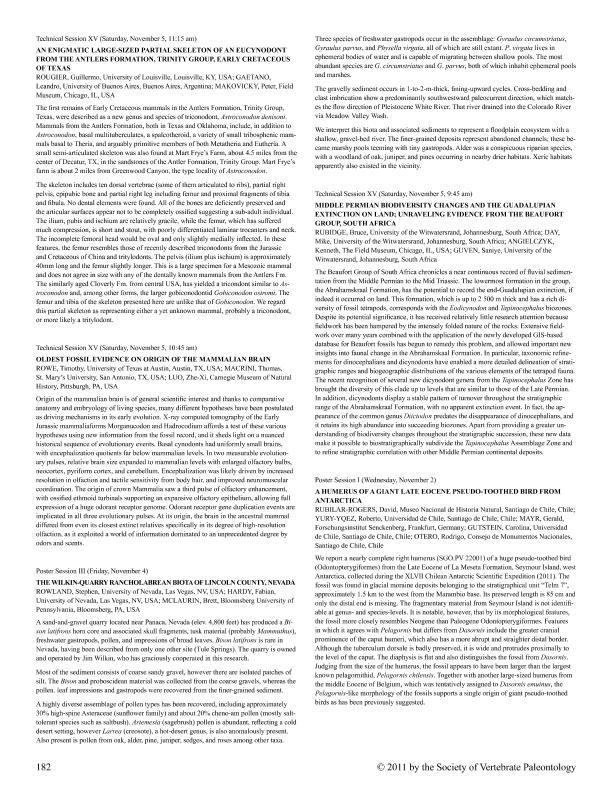Evento
An enigmatic large-sized partial skeleton of an eucynodont from the Antlers Formation, Trinity Group, Early Cretaceous of Texas
Tipo del evento:
Reunión
Nombre del evento:
71th Meeting Society of Vertebrate Paleontology
Fecha del evento:
02/11/2011
Institución Organizadora:
Society of Vertebrate Paleontology;
Título de la revista:
71th Meeting Society of Vertebrate Paleontology
Editorial:
Society of Vertebrate Paleontology
ISSN:
1937-2809
Idioma:
Inglés
Clasificación temática:
Resumen
The first remains of Early Cretaceous mammals in the Antlers Formation, Trinity Group, Texas, were described as a new genus and species of triconodont, Astroconodon denisoni. Mammals from the Antlers Formation, both in Texas and Oklahoma, include, in addition to Astroconodon, basal multituberculates, a spalcotheroid, a variety of small tribosphenic mammals basal to Theria, and arguably primitive members of both Metatheria and Eutheria. A small semi-articulated skeleton was also found at Mart Frye?s Farm, about 4.5 miles from the center of Decatur, TX, in the sandstones of the Antler Formation, Trinity Group. Mart Frye?s farm is about 2 miles from Greenwood Canyon, the type locality of Astroconodon. The skeleton includes ten dorsal vertebrae (some of them articulated to ribs), partial right pelvis, epipubic bone and partial right leg including femur and proximal fragments of tibia and fibula. No dental elements were found. All of the bones are deficiently preserved and the articular surfaces appear not to be completely ossified suggesting a sub-adult individual. The ilium, pubis and ischium are relatively gracile, while the femur, which has suffered much compression, is short and stout, with poorly differentiated laminar trocanters and neck. The incomplete femoral head would be oval and only slightly medially inflected. In these features, the femur resembles those of recently described triconodonts from the Jurassic and Cretaceous of China and tritylodonts. The pelvis (ilium plus ischium) is approximately 40mm long and the femur slightly longer. This is a large specimen for a Mesozoic mammal and does not agree in size with any of the dentally known mammals from the Antlers Fm. The similarly aged Cloverly Fm. from central USA, has yielded a tricondont similar to Astroconodon and, among other forms, the larger gobiconodontid Gobiconodon ostromi. The femur and tibia of the skeleton presented here are unlike that of Gobiconodon. We regard this partial skeleton as representing either a yet unknown mammal, probably a triconodont, or more likely a tritylodont.
Palabras clave:
CYNODONT
,
EARLY CRETACEOUS
,
TEXAS
Archivos asociados
Licencia
Identificadores
Colecciones
Eventos(IDEAN)
Eventos de INSTITUTO DE ESTUDIOS ANDINOS "DON PABLO GROEBER"
Eventos de INSTITUTO DE ESTUDIOS ANDINOS "DON PABLO GROEBER"
Citación
An enigmatic large-sized partial skeleton of an eucynodont from the Antlers Formation, Trinity Group, Early Cretaceous of Texas; 71th Meeting Society of Vertebrate Paleontology; Las Vegas; Estados Unidos; 2011; 182-182
Compartir




